|

by Simon Tomlinson
28 January 2013
from
DailyMail Website
What a Waste!
Picture from Space Reveals How
New U.S. Oil Field
is Burning Off Enough Gas to
Power Chicago and Washington
Because It's Cheaper Than
Selling It
This incredible picture from space shows how the U.S. oil industry
has boomed to such an extent that a gas field now burns as brightly
as a major city.
The rapid increase in shale oil production means it is now often
more economical to 'flare off' unwanted gas than to sell it.
As a result, one field in North Dakota, the state leading the energy
revolution, is now burning off enough gas to power all the homes in
Chicago and Washington D.C. combined.
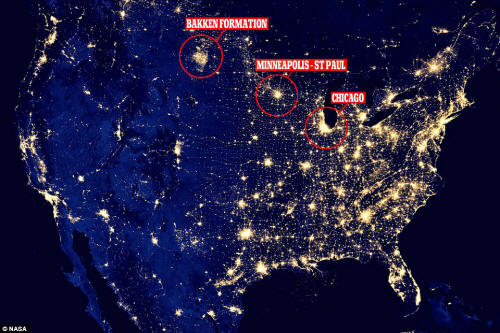
Wasting energy:
This NASA satellite
image shows how the gas being burned off
at the Bakken oil
field in North Dakota is almost as bright as
the light emitted
from major U.S. cities such as
Minneapolis-St Paul
and Chicago
In a recently released satellite image from NASA, the light being
given off at the Bakken formation, almost twice the size of Wales,
easily competes in intensity with that being emitted from those
cities.
The volume of gas going up in flames at the plant rose by around 50
per cent last year alone in a practice that is causing growing
concern about the waste of resources and the impact on the
environment, according to the Financial Times.
The trend, which is being replicated in other shale regions such as
Texas, has made the U.S. one of the world's worst offenders for gas
flaring after the amount it burns off has tripled in the last five
years, according to World Bank estimates.
The boom has come after advances in a
process known as fracking,
where a mixture of sand, water and chemicals is pumped into rocks to
open cracks in a reservoir.
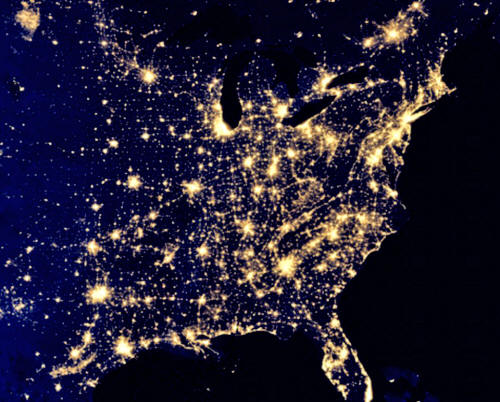
Illuminated:
The trend, which is
being replicated in other shale regions
such as Texas, has
made the U.S. one of the world's
worst offenders for
gas flaring
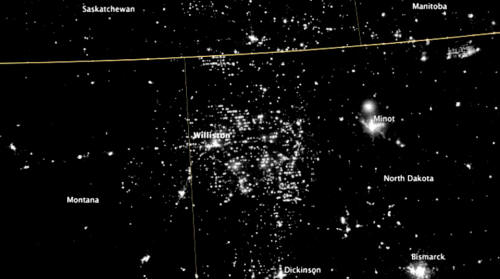
Burning:
This map shows how
North Dakota is now speckled
with gas flares after
a boom in shale oil production in recent years
In North Dakota, 150 oil companies have flooded the region drilling
up to eight new wells a day and are producing roughly 660,000
barrels of oil.
It has reduced the country's need for oil imports and created
thousands of jobs, but the abundant supplies of gas it has unlocked
have outpaced development of infrastructure needed to store and pump
it to populations.
More than 1,000 wells were connected to the Bakken system in 2012,
for example, but that has not been enough to cut the proportion of
the state’s gas being flared, currently at about 30 per cent.
But with gas prices having dropped from their 2008 peak of more than
$13 per million British thermal units to just $3.40 because of
increased production of the resource it is now uneconomic to build
pipelines and storage tanks.
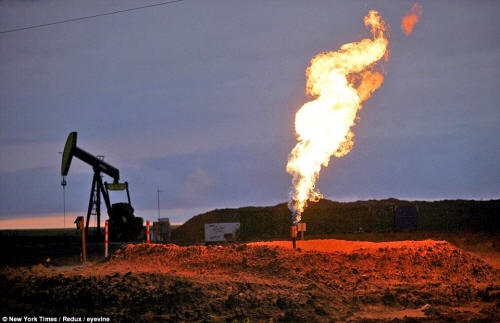
Up in flames:
A ground flare burns
gas at a well near Ray, North Dakota,
where about 30 per
cent of the natural gas produced is burned as waste
HOW FRACKING HAS FUELLED
AMERICA'S INSATIABLE APPETITE FOR OIL AND GAS
With its voracious appetite for
energy and a desire to be less reliant on imports, the U.S.
became the first country to exploit the potential of fracking.
The process - shorthand for hydraulic fracturing - involves
creating little explosions underground, then injecting water and
chemicals to release gas and oil trapped in cavities in shale
rocks.
In 1996, the U.S. produced just 0.3trillion cubic feet of shale
gas.
By 2011, however, that figure had leapt to 7.8trillion, allowing
America to transform itself from an importer to a net exporter
of gas.
But the abundant supplies of gas have outpaced development of
infrastructure around oil plants.
And with gas prices having dropped from their 2008 peak of more
than $13 per million British thermal units to just $3.40 it is
now uneconomic to build pipelines and storage tanks.
As a result, much of the gas is burned off instead.
Shale gas reserves are plentiful and widespread across much of
the world, but until developments in fracking it has been
largely inaccessible.
In China, explorable shale reserves are estimated at 86trillion
cubic feet, enough to supply the nation's needs for two
centuries
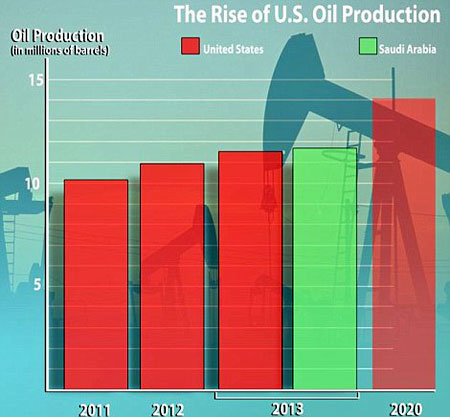
Liquid gold:
Graphic showing how
U.S. oil production
outrip that of Saudi
Arabia
Adam Brandt, a Stanford academic who studies greenhouse gas
emissions from fossil fuels, told the FT:
'The situation in the shale
oilfields is similar to the early days of the US oil industry.
Companies are in a race with their competitors to develop the
resource, which means there is little incentive to delay
production to reduce flaring.'
Flaring - which has increased emissions
from North Dakota by around 20 per cent - has been a serious concern
to investors and campaigners because of waste and damage to the
environment.
Local farmers complain the constant fires are polluting the
atmosphere and say they suspect state officials are granting
exemptions rather than dealing with the issue.
The North Dakota legislature is, however, considering a bill which
could offer tax breaks to encourage a reduction in flaring.
NASA captures amazing images of Earth at night
|





